Ethics Application Form: HRM Strategies Impact on Ryanair Employees
VerifiedAdded on 2022/12/01
|19
|5293
|85
Homework Assignment
AI Summary
This document is an ethics application form submitted by an undergraduate student for a research project evaluating the impact of human resource management (HRM) strategies on employees, specifically within Ryanair. The application includes sections detailing personal information, project details such as the purpose and outline of the investigation, ethical considerations including participant consent, confidentiality, and potential risks, and health and safety measures. The research aims to explore the current HRM strategies employed by Ryanair and their effects on employee engagement, job satisfaction, and retention. The methodology involves questionnaires administered to 30 Ryanair employees. The application emphasizes the importance of ethical considerations throughout the research process, ensuring participant safety, data privacy, and adherence to ethical guidelines. It also addresses potential risks to both participants and the researcher, outlining measures to mitigate these risks.
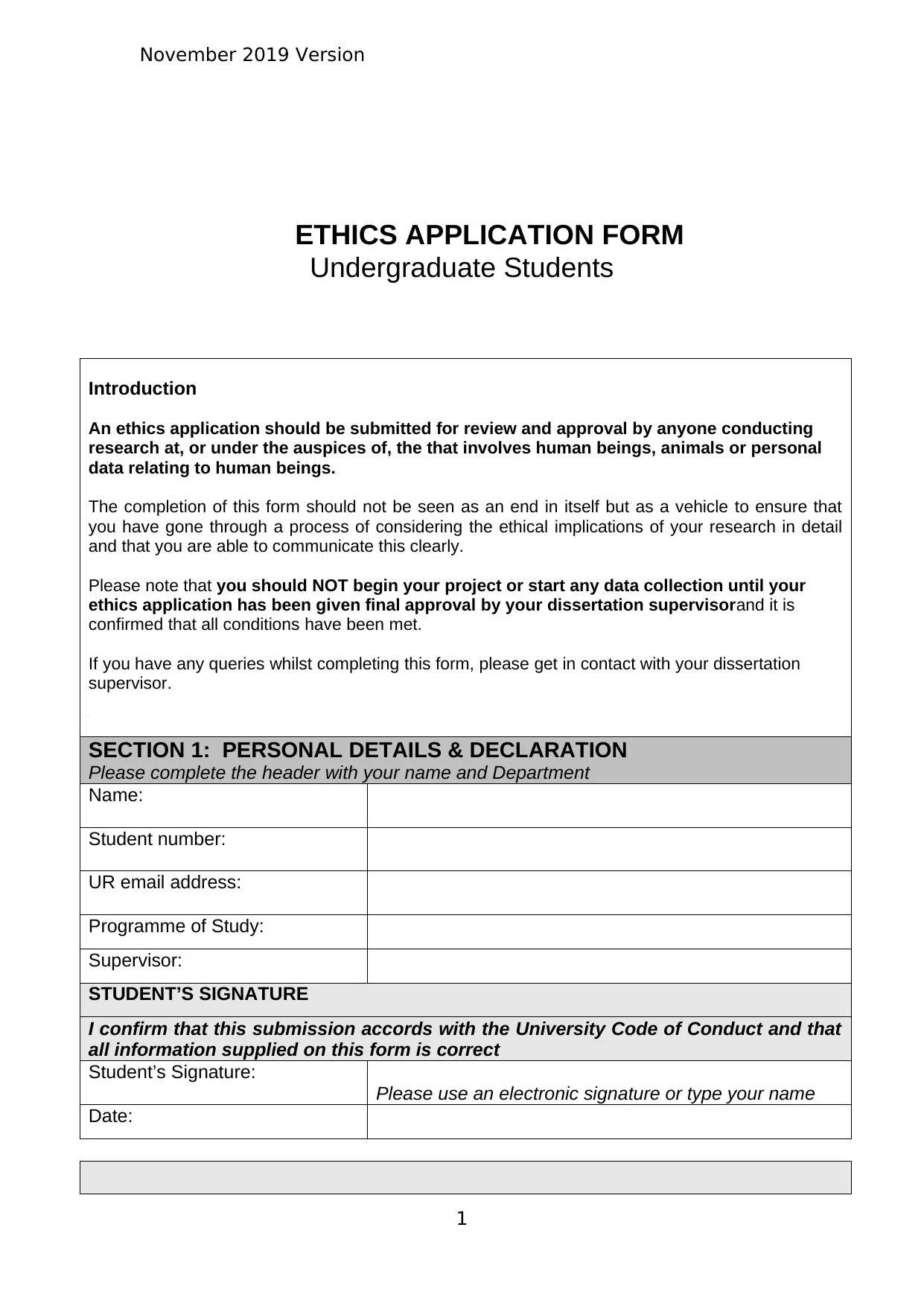
November 2019 Version
ETHICS APPLICATION FORM
Undergraduate Students
Introduction
An ethics application should be submitted for review and approval by anyone conducting
research at, or under the auspices of, the that involves human beings, animals or personal
data relating to human beings.
The completion of this form should not be seen as an end in itself but as a vehicle to ensure that
you have gone through a process of considering the ethical implications of your research in detail
and that you are able to communicate this clearly.
Please note that you should NOT begin your project or start any data collection until your
ethics application has been given final approval by your dissertation supervisorand it is
confirmed that all conditions have been met.
If you have any queries whilst completing this form, please get in contact with your dissertation
supervisor.
SECTION 1: PERSONAL DETAILS & DECLARATION
Please complete the header with your name and Department
Name:
Student number:
UR email address:
Programme of Study:
Supervisor:
STUDENT’S SIGNATURE
I confirm that this submission accords with the University Code of Conduct and that
all information supplied on this form is correct
Student’s Signature:
Please use an electronic signature or type your name
Date:
1
ETHICS APPLICATION FORM
Undergraduate Students
Introduction
An ethics application should be submitted for review and approval by anyone conducting
research at, or under the auspices of, the that involves human beings, animals or personal
data relating to human beings.
The completion of this form should not be seen as an end in itself but as a vehicle to ensure that
you have gone through a process of considering the ethical implications of your research in detail
and that you are able to communicate this clearly.
Please note that you should NOT begin your project or start any data collection until your
ethics application has been given final approval by your dissertation supervisorand it is
confirmed that all conditions have been met.
If you have any queries whilst completing this form, please get in contact with your dissertation
supervisor.
SECTION 1: PERSONAL DETAILS & DECLARATION
Please complete the header with your name and Department
Name:
Student number:
UR email address:
Programme of Study:
Supervisor:
STUDENT’S SIGNATURE
I confirm that this submission accords with the University Code of Conduct and that
all information supplied on this form is correct
Student’s Signature:
Please use an electronic signature or type your name
Date:
1
Paraphrase This Document
Need a fresh take? Get an instant paraphrase of this document with our AI Paraphraser
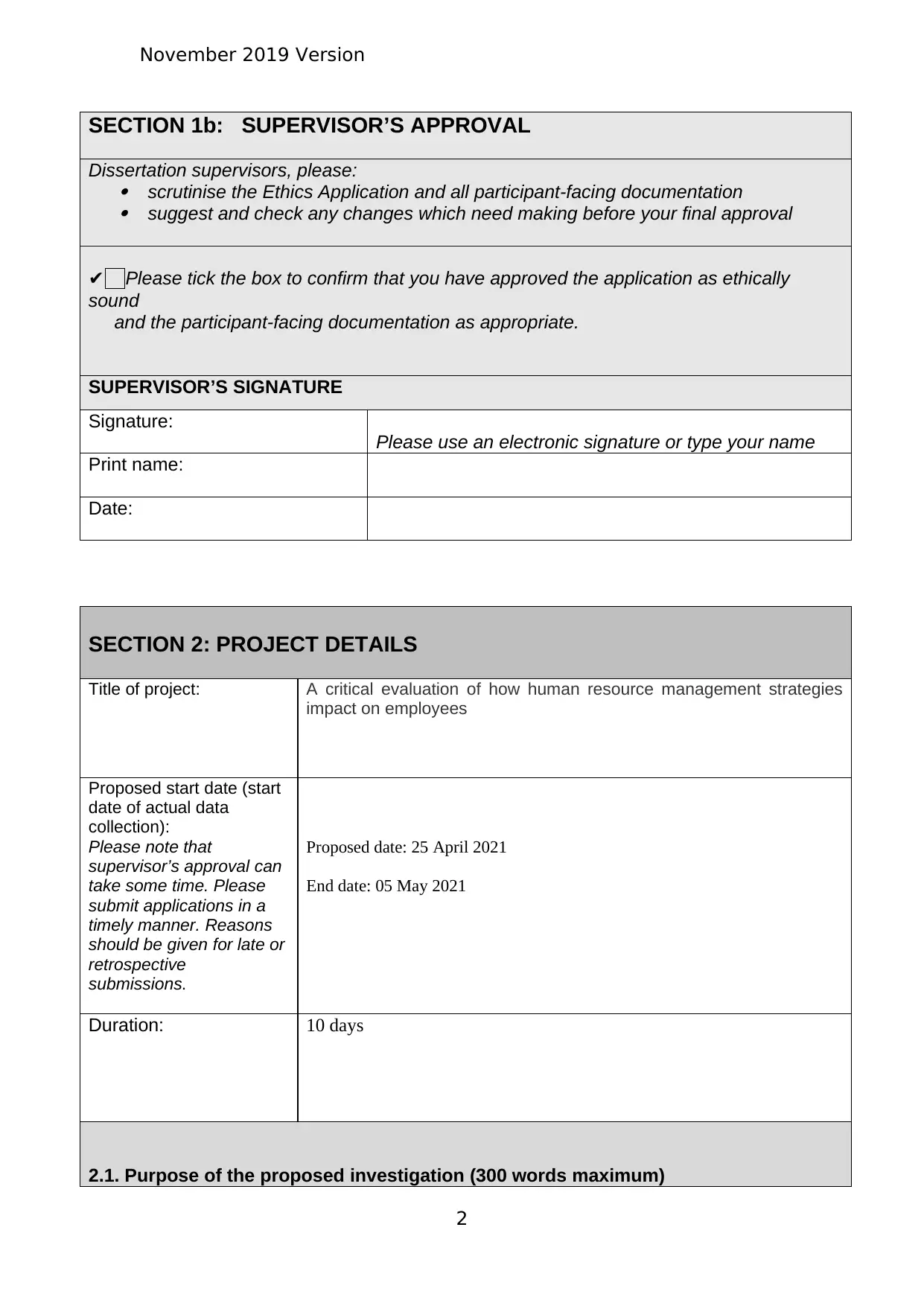
November 2019 Version
SECTION 1b: SUPERVISOR’S APPROVAL
Dissertation supervisors, please:
scrutinise the Ethics Application and all participant-facing documentation
suggest and check any changes which need making before your final approval
✔ Please tick the box to confirm that you have approved the application as ethically
sound
and the participant-facing documentation as appropriate.
SUPERVISOR’S SIGNATURE
Signature:
Please use an electronic signature or type your name
Print name:
Date:
SECTION 2: PROJECT DETAILS
Title of project: A critical evaluation of how human resource management strategies
impact on employees
Proposed start date (start
date of actual data
collection):
Please note that
supervisor’s approval can
take some time. Please
submit applications in a
timely manner. Reasons
should be given for late or
retrospective
submissions.
Proposed date: 25 April 2021
End date: 05 May 2021
Duration: 10 days
2.1. Purpose of the proposed investigation (300 words maximum)
2
SECTION 1b: SUPERVISOR’S APPROVAL
Dissertation supervisors, please:
scrutinise the Ethics Application and all participant-facing documentation
suggest and check any changes which need making before your final approval
✔ Please tick the box to confirm that you have approved the application as ethically
sound
and the participant-facing documentation as appropriate.
SUPERVISOR’S SIGNATURE
Signature:
Please use an electronic signature or type your name
Print name:
Date:
SECTION 2: PROJECT DETAILS
Title of project: A critical evaluation of how human resource management strategies
impact on employees
Proposed start date (start
date of actual data
collection):
Please note that
supervisor’s approval can
take some time. Please
submit applications in a
timely manner. Reasons
should be given for late or
retrospective
submissions.
Proposed date: 25 April 2021
End date: 05 May 2021
Duration: 10 days
2.1. Purpose of the proposed investigation (300 words maximum)
2
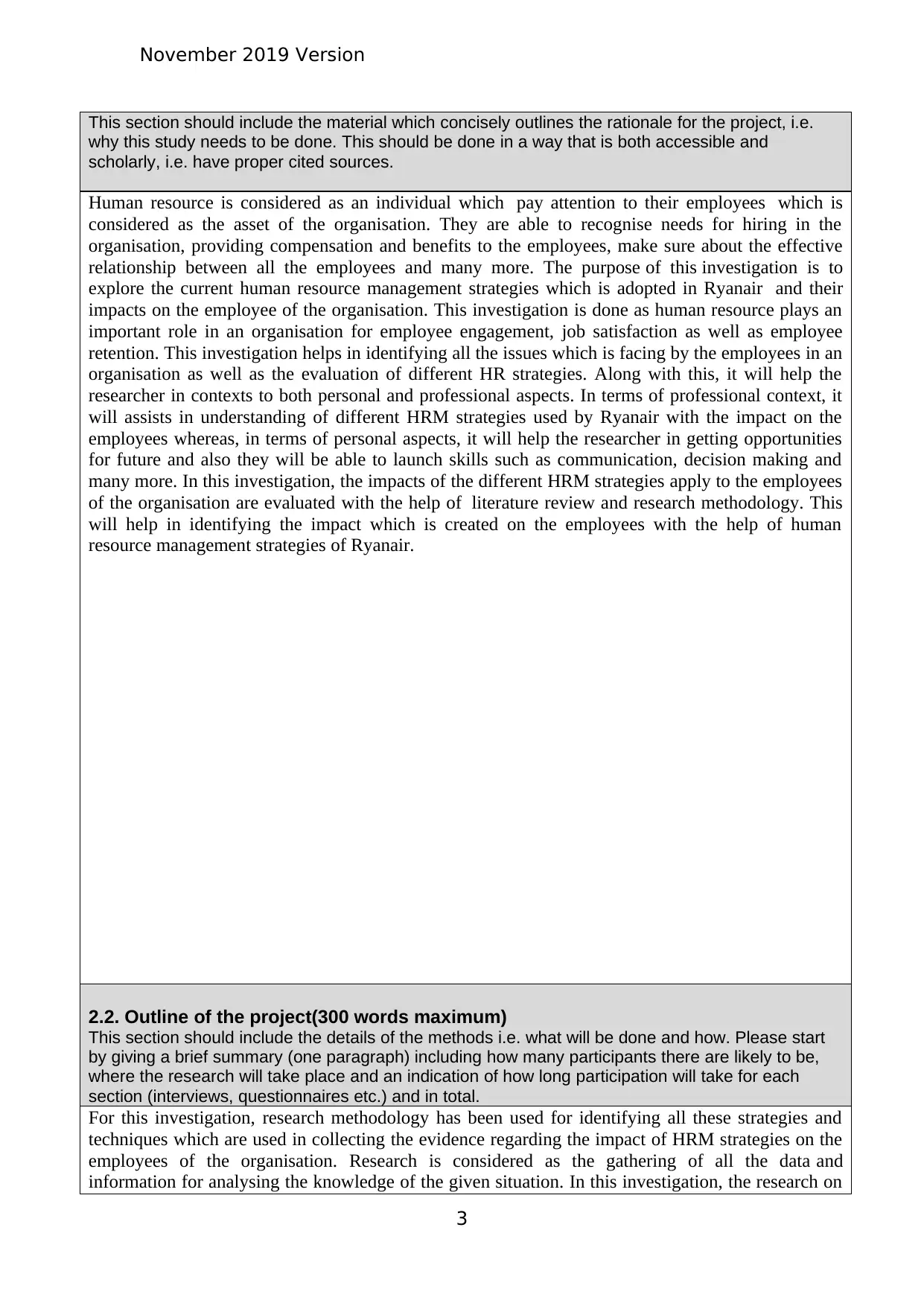
November 2019 Version
This section should include the material which concisely outlines the rationale for the project, i.e.
why this study needs to be done. This should be done in a way that is both accessible and
scholarly, i.e. have proper cited sources.
Human resource is considered as an individual which pay attention to their employees which is
considered as the asset of the organisation. They are able to recognise needs for hiring in the
organisation, providing compensation and benefits to the employees, make sure about the effective
relationship between all the employees and many more. The purpose of this investigation is to
explore the current human resource management strategies which is adopted in Ryanair and their
impacts on the employee of the organisation. This investigation is done as human resource plays an
important role in an organisation for employee engagement, job satisfaction as well as employee
retention. This investigation helps in identifying all the issues which is facing by the employees in an
organisation as well as the evaluation of different HR strategies. Along with this, it will help the
researcher in contexts to both personal and professional aspects. In terms of professional context, it
will assists in understanding of different HRM strategies used by Ryanair with the impact on the
employees whereas, in terms of personal aspects, it will help the researcher in getting opportunities
for future and also they will be able to launch skills such as communication, decision making and
many more. In this investigation, the impacts of the different HRM strategies apply to the employees
of the organisation are evaluated with the help of literature review and research methodology. This
will help in identifying the impact which is created on the employees with the help of human
resource management strategies of Ryanair.
2.2. Outline of the project(300 words maximum)
This section should include the details of the methods i.e. what will be done and how. Please start
by giving a brief summary (one paragraph) including how many participants there are likely to be,
where the research will take place and an indication of how long participation will take for each
section (interviews, questionnaires etc.) and in total.
For this investigation, research methodology has been used for identifying all these strategies and
techniques which are used in collecting the evidence regarding the impact of HRM strategies on the
employees of the organisation. Research is considered as the gathering of all the data and
information for analysing the knowledge of the given situation. In this investigation, the research on
3
This section should include the material which concisely outlines the rationale for the project, i.e.
why this study needs to be done. This should be done in a way that is both accessible and
scholarly, i.e. have proper cited sources.
Human resource is considered as an individual which pay attention to their employees which is
considered as the asset of the organisation. They are able to recognise needs for hiring in the
organisation, providing compensation and benefits to the employees, make sure about the effective
relationship between all the employees and many more. The purpose of this investigation is to
explore the current human resource management strategies which is adopted in Ryanair and their
impacts on the employee of the organisation. This investigation is done as human resource plays an
important role in an organisation for employee engagement, job satisfaction as well as employee
retention. This investigation helps in identifying all the issues which is facing by the employees in an
organisation as well as the evaluation of different HR strategies. Along with this, it will help the
researcher in contexts to both personal and professional aspects. In terms of professional context, it
will assists in understanding of different HRM strategies used by Ryanair with the impact on the
employees whereas, in terms of personal aspects, it will help the researcher in getting opportunities
for future and also they will be able to launch skills such as communication, decision making and
many more. In this investigation, the impacts of the different HRM strategies apply to the employees
of the organisation are evaluated with the help of literature review and research methodology. This
will help in identifying the impact which is created on the employees with the help of human
resource management strategies of Ryanair.
2.2. Outline of the project(300 words maximum)
This section should include the details of the methods i.e. what will be done and how. Please start
by giving a brief summary (one paragraph) including how many participants there are likely to be,
where the research will take place and an indication of how long participation will take for each
section (interviews, questionnaires etc.) and in total.
For this investigation, research methodology has been used for identifying all these strategies and
techniques which are used in collecting the evidence regarding the impact of HRM strategies on the
employees of the organisation. Research is considered as the gathering of all the data and
information for analysing the knowledge of the given situation. In this investigation, the research on
3
⊘ This is a preview!⊘
Do you want full access?
Subscribe today to unlock all pages.

Trusted by 1+ million students worldwide
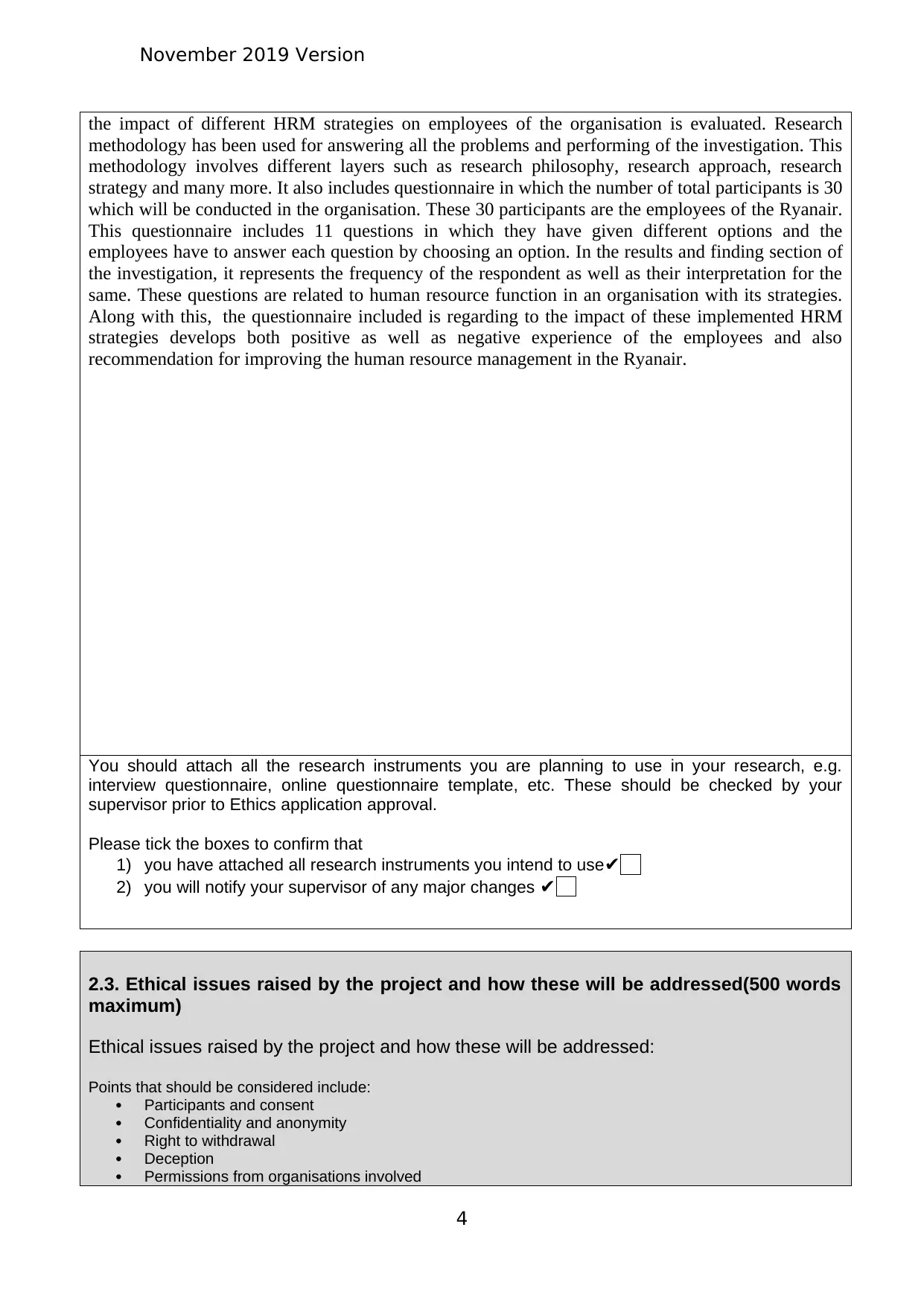
November 2019 Version
the impact of different HRM strategies on employees of the organisation is evaluated. Research
methodology has been used for answering all the problems and performing of the investigation. This
methodology involves different layers such as research philosophy, research approach, research
strategy and many more. It also includes questionnaire in which the number of total participants is 30
which will be conducted in the organisation. These 30 participants are the employees of the Ryanair.
This questionnaire includes 11 questions in which they have given different options and the
employees have to answer each question by choosing an option. In the results and finding section of
the investigation, it represents the frequency of the respondent as well as their interpretation for the
same. These questions are related to human resource function in an organisation with its strategies.
Along with this, the questionnaire included is regarding to the impact of these implemented HRM
strategies develops both positive as well as negative experience of the employees and also
recommendation for improving the human resource management in the Ryanair.
You should attach all the research instruments you are planning to use in your research, e.g.
interview questionnaire, online questionnaire template, etc. These should be checked by your
supervisor prior to Ethics application approval.
Please tick the boxes to confirm that
1) you have attached all research instruments you intend to use✔
2) you will notify your supervisor of any major changes ✔
2.3. Ethical issues raised by the project and how these will be addressed(500 words
maximum)
Ethical issues raised by the project and how these will be addressed:
Points that should be considered include:
Participants and consent
Confidentiality and anonymity
Right to withdrawal
Deception
Permissions from organisations involved
4
the impact of different HRM strategies on employees of the organisation is evaluated. Research
methodology has been used for answering all the problems and performing of the investigation. This
methodology involves different layers such as research philosophy, research approach, research
strategy and many more. It also includes questionnaire in which the number of total participants is 30
which will be conducted in the organisation. These 30 participants are the employees of the Ryanair.
This questionnaire includes 11 questions in which they have given different options and the
employees have to answer each question by choosing an option. In the results and finding section of
the investigation, it represents the frequency of the respondent as well as their interpretation for the
same. These questions are related to human resource function in an organisation with its strategies.
Along with this, the questionnaire included is regarding to the impact of these implemented HRM
strategies develops both positive as well as negative experience of the employees and also
recommendation for improving the human resource management in the Ryanair.
You should attach all the research instruments you are planning to use in your research, e.g.
interview questionnaire, online questionnaire template, etc. These should be checked by your
supervisor prior to Ethics application approval.
Please tick the boxes to confirm that
1) you have attached all research instruments you intend to use✔
2) you will notify your supervisor of any major changes ✔
2.3. Ethical issues raised by the project and how these will be addressed(500 words
maximum)
Ethical issues raised by the project and how these will be addressed:
Points that should be considered include:
Participants and consent
Confidentiality and anonymity
Right to withdrawal
Deception
Permissions from organisations involved
4
Paraphrase This Document
Need a fresh take? Get an instant paraphrase of this document with our AI Paraphraser
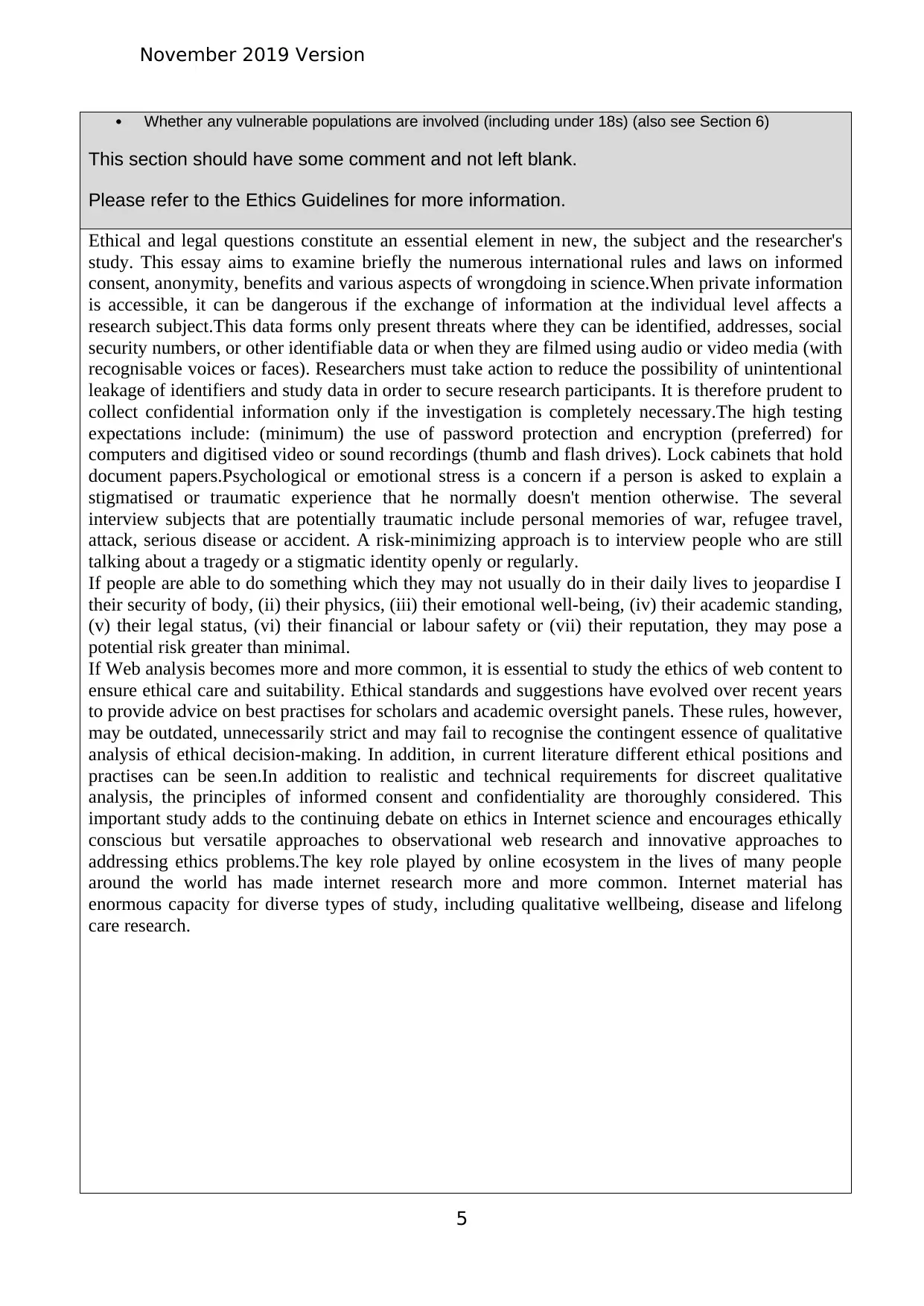
November 2019 Version
Whether any vulnerable populations are involved (including under 18s) (also see Section 6)
This section should have some comment and not left blank.
Please refer to the Ethics Guidelines for more information.
Ethical and legal questions constitute an essential element in new, the subject and the researcher's
study. This essay aims to examine briefly the numerous international rules and laws on informed
consent, anonymity, benefits and various aspects of wrongdoing in science.When private information
is accessible, it can be dangerous if the exchange of information at the individual level affects a
research subject.This data forms only present threats where they can be identified, addresses, social
security numbers, or other identifiable data or when they are filmed using audio or video media (with
recognisable voices or faces). Researchers must take action to reduce the possibility of unintentional
leakage of identifiers and study data in order to secure research participants. It is therefore prudent to
collect confidential information only if the investigation is completely necessary.The high testing
expectations include: (minimum) the use of password protection and encryption (preferred) for
computers and digitised video or sound recordings (thumb and flash drives). Lock cabinets that hold
document papers.Psychological or emotional stress is a concern if a person is asked to explain a
stigmatised or traumatic experience that he normally doesn't mention otherwise. The several
interview subjects that are potentially traumatic include personal memories of war, refugee travel,
attack, serious disease or accident. A risk-minimizing approach is to interview people who are still
talking about a tragedy or a stigmatic identity openly or regularly.
If people are able to do something which they may not usually do in their daily lives to jeopardise I
their security of body, (ii) their physics, (iii) their emotional well-being, (iv) their academic standing,
(v) their legal status, (vi) their financial or labour safety or (vii) their reputation, they may pose a
potential risk greater than minimal.
If Web analysis becomes more and more common, it is essential to study the ethics of web content to
ensure ethical care and suitability. Ethical standards and suggestions have evolved over recent years
to provide advice on best practises for scholars and academic oversight panels. These rules, however,
may be outdated, unnecessarily strict and may fail to recognise the contingent essence of qualitative
analysis of ethical decision-making. In addition, in current literature different ethical positions and
practises can be seen.In addition to realistic and technical requirements for discreet qualitative
analysis, the principles of informed consent and confidentiality are thoroughly considered. This
important study adds to the continuing debate on ethics in Internet science and encourages ethically
conscious but versatile approaches to observational web research and innovative approaches to
addressing ethics problems.The key role played by online ecosystem in the lives of many people
around the world has made internet research more and more common. Internet material has
enormous capacity for diverse types of study, including qualitative wellbeing, disease and lifelong
care research.
5
Whether any vulnerable populations are involved (including under 18s) (also see Section 6)
This section should have some comment and not left blank.
Please refer to the Ethics Guidelines for more information.
Ethical and legal questions constitute an essential element in new, the subject and the researcher's
study. This essay aims to examine briefly the numerous international rules and laws on informed
consent, anonymity, benefits and various aspects of wrongdoing in science.When private information
is accessible, it can be dangerous if the exchange of information at the individual level affects a
research subject.This data forms only present threats where they can be identified, addresses, social
security numbers, or other identifiable data or when they are filmed using audio or video media (with
recognisable voices or faces). Researchers must take action to reduce the possibility of unintentional
leakage of identifiers and study data in order to secure research participants. It is therefore prudent to
collect confidential information only if the investigation is completely necessary.The high testing
expectations include: (minimum) the use of password protection and encryption (preferred) for
computers and digitised video or sound recordings (thumb and flash drives). Lock cabinets that hold
document papers.Psychological or emotional stress is a concern if a person is asked to explain a
stigmatised or traumatic experience that he normally doesn't mention otherwise. The several
interview subjects that are potentially traumatic include personal memories of war, refugee travel,
attack, serious disease or accident. A risk-minimizing approach is to interview people who are still
talking about a tragedy or a stigmatic identity openly or regularly.
If people are able to do something which they may not usually do in their daily lives to jeopardise I
their security of body, (ii) their physics, (iii) their emotional well-being, (iv) their academic standing,
(v) their legal status, (vi) their financial or labour safety or (vii) their reputation, they may pose a
potential risk greater than minimal.
If Web analysis becomes more and more common, it is essential to study the ethics of web content to
ensure ethical care and suitability. Ethical standards and suggestions have evolved over recent years
to provide advice on best practises for scholars and academic oversight panels. These rules, however,
may be outdated, unnecessarily strict and may fail to recognise the contingent essence of qualitative
analysis of ethical decision-making. In addition, in current literature different ethical positions and
practises can be seen.In addition to realistic and technical requirements for discreet qualitative
analysis, the principles of informed consent and confidentiality are thoroughly considered. This
important study adds to the continuing debate on ethics in Internet science and encourages ethically
conscious but versatile approaches to observational web research and innovative approaches to
addressing ethics problems.The key role played by online ecosystem in the lives of many people
around the world has made internet research more and more common. Internet material has
enormous capacity for diverse types of study, including qualitative wellbeing, disease and lifelong
care research.
5

November 2019 Version
6
6
⊘ This is a preview!⊘
Do you want full access?
Subscribe today to unlock all pages.

Trusted by 1+ million students worldwide
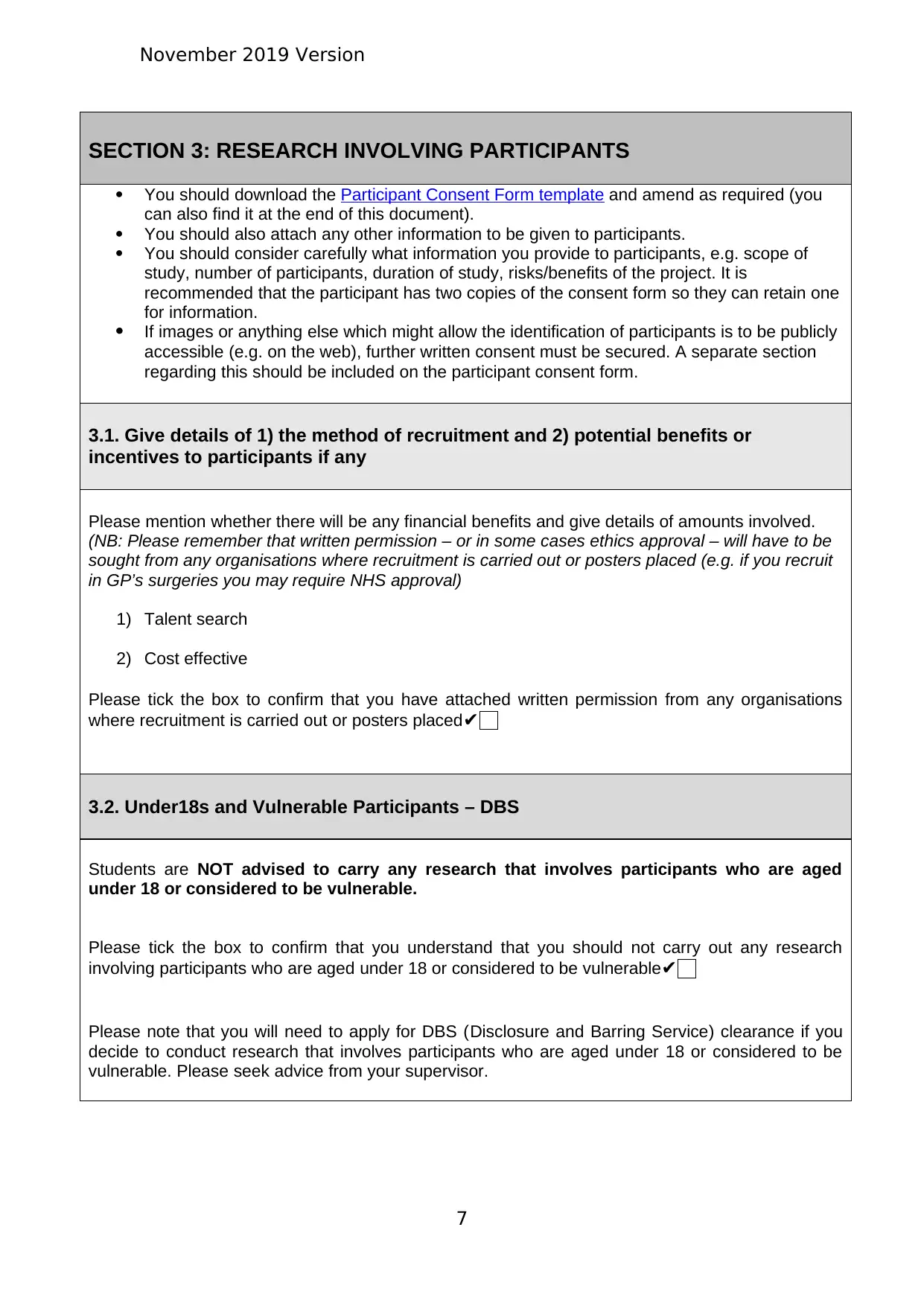
November 2019 Version
SECTION 3: RESEARCH INVOLVING PARTICIPANTS
You should download the Participant Consent Form template and amend as required (you
can also find it at the end of this document).
You should also attach any other information to be given to participants.
You should consider carefully what information you provide to participants, e.g. scope of
study, number of participants, duration of study, risks/benefits of the project. It is
recommended that the participant has two copies of the consent form so they can retain one
for information.
If images or anything else which might allow the identification of participants is to be publicly
accessible (e.g. on the web), further written consent must be secured. A separate section
regarding this should be included on the participant consent form.
3.1. Give details of 1) the method of recruitment and 2) potential benefits or
incentives to participants if any
Please mention whether there will be any financial benefits and give details of amounts involved.
(NB: Please remember that written permission – or in some cases ethics approval – will have to be
sought from any organisations where recruitment is carried out or posters placed (e.g. if you recruit
in GP’s surgeries you may require NHS approval)
1) Talent search
2) Cost effective
Please tick the box to confirm that you have attached written permission from any organisations
where recruitment is carried out or posters placed✔
3.2. Under18s and Vulnerable Participants – DBS
Students are NOT advised to carry any research that involves participants who are aged
under 18 or considered to be vulnerable.
Please tick the box to confirm that you understand that you should not carry out any research
involving participants who are aged under 18 or considered to be vulnerable✔
Please note that you will need to apply for DBS (Disclosure and Barring Service) clearance if you
decide to conduct research that involves participants who are aged under 18 or considered to be
vulnerable. Please seek advice from your supervisor.
7
SECTION 3: RESEARCH INVOLVING PARTICIPANTS
You should download the Participant Consent Form template and amend as required (you
can also find it at the end of this document).
You should also attach any other information to be given to participants.
You should consider carefully what information you provide to participants, e.g. scope of
study, number of participants, duration of study, risks/benefits of the project. It is
recommended that the participant has two copies of the consent form so they can retain one
for information.
If images or anything else which might allow the identification of participants is to be publicly
accessible (e.g. on the web), further written consent must be secured. A separate section
regarding this should be included on the participant consent form.
3.1. Give details of 1) the method of recruitment and 2) potential benefits or
incentives to participants if any
Please mention whether there will be any financial benefits and give details of amounts involved.
(NB: Please remember that written permission – or in some cases ethics approval – will have to be
sought from any organisations where recruitment is carried out or posters placed (e.g. if you recruit
in GP’s surgeries you may require NHS approval)
1) Talent search
2) Cost effective
Please tick the box to confirm that you have attached written permission from any organisations
where recruitment is carried out or posters placed✔
3.2. Under18s and Vulnerable Participants – DBS
Students are NOT advised to carry any research that involves participants who are aged
under 18 or considered to be vulnerable.
Please tick the box to confirm that you understand that you should not carry out any research
involving participants who are aged under 18 or considered to be vulnerable✔
Please note that you will need to apply for DBS (Disclosure and Barring Service) clearance if you
decide to conduct research that involves participants who are aged under 18 or considered to be
vulnerable. Please seek advice from your supervisor.
7
Paraphrase This Document
Need a fresh take? Get an instant paraphrase of this document with our AI Paraphraser
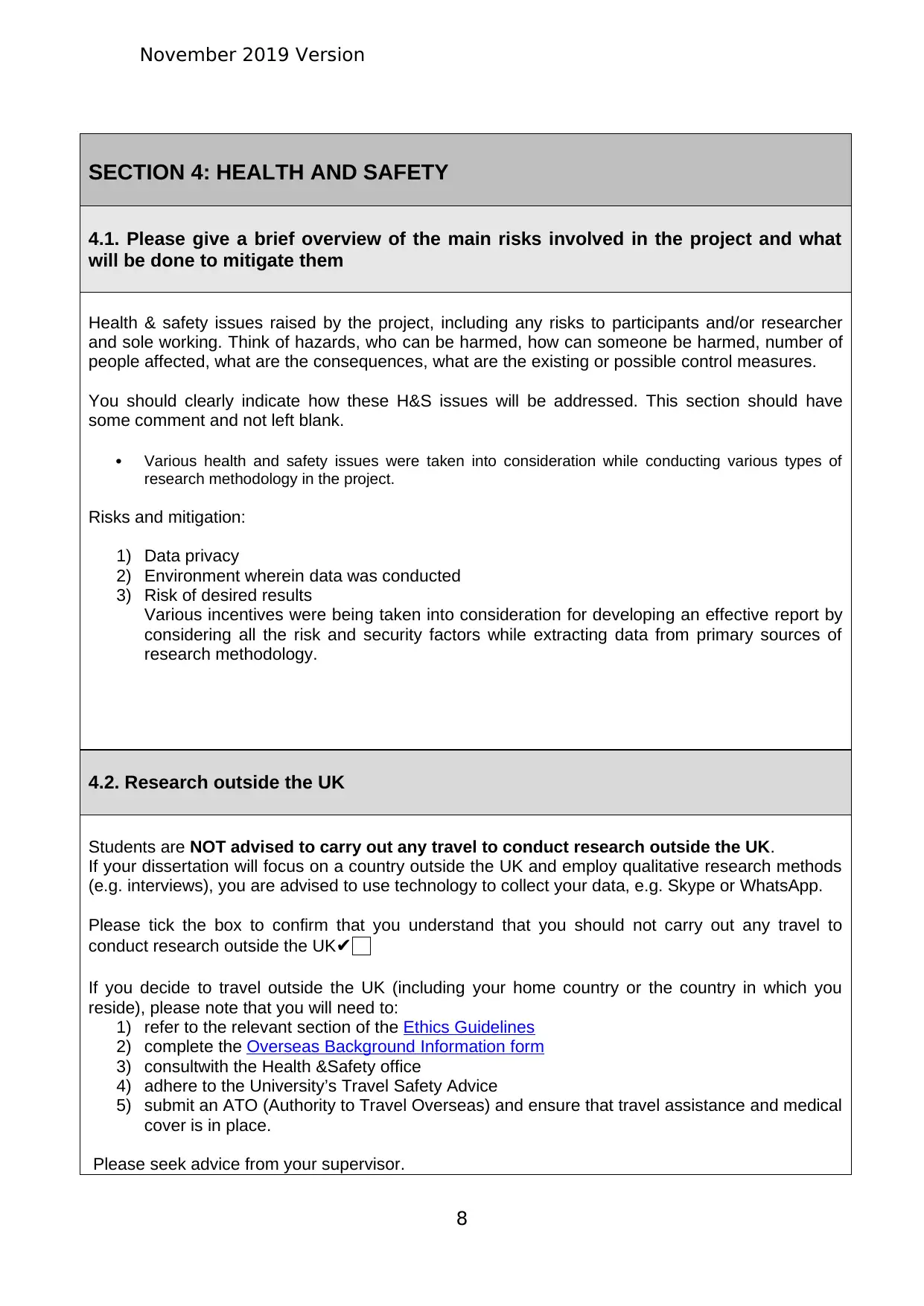
November 2019 Version
SECTION 4: HEALTH AND SAFETY
4.1. Please give a brief overview of the main risks involved in the project and what
will be done to mitigate them
Health & safety issues raised by the project, including any risks to participants and/or researcher
and sole working. Think of hazards, who can be harmed, how can someone be harmed, number of
people affected, what are the consequences, what are the existing or possible control measures.
You should clearly indicate how these H&S issues will be addressed. This section should have
some comment and not left blank.
Various health and safety issues were taken into consideration while conducting various types of
research methodology in the project.
Risks and mitigation:
1) Data privacy
2) Environment wherein data was conducted
3) Risk of desired results
Various incentives were being taken into consideration for developing an effective report by
considering all the risk and security factors while extracting data from primary sources of
research methodology.
4.2. Research outside the UK
Students are NOT advised to carry out any travel to conduct research outside the UK.
If your dissertation will focus on a country outside the UK and employ qualitative research methods
(e.g. interviews), you are advised to use technology to collect your data, e.g. Skype or WhatsApp.
Please tick the box to confirm that you understand that you should not carry out any travel to
conduct research outside the UK✔
If you decide to travel outside the UK (including your home country or the country in which you
reside), please note that you will need to:
1) refer to the relevant section of the Ethics Guidelines
2) complete the Overseas Background Information form
3) consultwith the Health &Safety office
4) adhere to the University’s Travel Safety Advice
5) submit an ATO (Authority to Travel Overseas) and ensure that travel assistance and medical
cover is in place.
Please seek advice from your supervisor.
8
SECTION 4: HEALTH AND SAFETY
4.1. Please give a brief overview of the main risks involved in the project and what
will be done to mitigate them
Health & safety issues raised by the project, including any risks to participants and/or researcher
and sole working. Think of hazards, who can be harmed, how can someone be harmed, number of
people affected, what are the consequences, what are the existing or possible control measures.
You should clearly indicate how these H&S issues will be addressed. This section should have
some comment and not left blank.
Various health and safety issues were taken into consideration while conducting various types of
research methodology in the project.
Risks and mitigation:
1) Data privacy
2) Environment wherein data was conducted
3) Risk of desired results
Various incentives were being taken into consideration for developing an effective report by
considering all the risk and security factors while extracting data from primary sources of
research methodology.
4.2. Research outside the UK
Students are NOT advised to carry out any travel to conduct research outside the UK.
If your dissertation will focus on a country outside the UK and employ qualitative research methods
(e.g. interviews), you are advised to use technology to collect your data, e.g. Skype or WhatsApp.
Please tick the box to confirm that you understand that you should not carry out any travel to
conduct research outside the UK✔
If you decide to travel outside the UK (including your home country or the country in which you
reside), please note that you will need to:
1) refer to the relevant section of the Ethics Guidelines
2) complete the Overseas Background Information form
3) consultwith the Health &Safety office
4) adhere to the University’s Travel Safety Advice
5) submit an ATO (Authority to Travel Overseas) and ensure that travel assistance and medical
cover is in place.
Please seek advice from your supervisor.
8
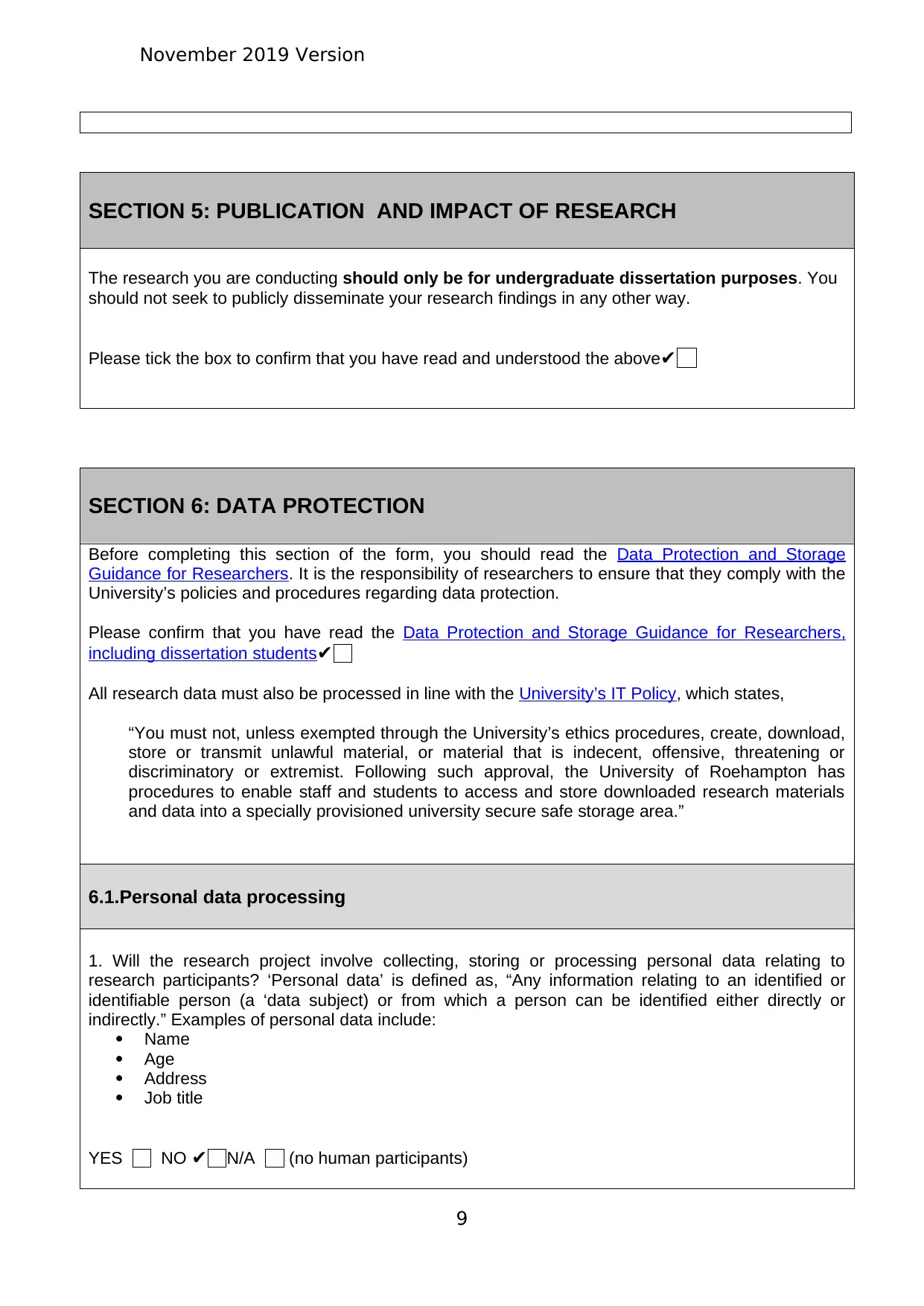
November 2019 Version
SECTION 5: PUBLICATION AND IMPACT OF RESEARCH
The research you are conducting should only be for undergraduate dissertation purposes. You
should not seek to publicly disseminate your research findings in any other way.
Please tick the box to confirm that you have read and understood the above✔
SECTION 6: DATA PROTECTION
Before completing this section of the form, you should read the Data Protection and Storage
Guidance for Researchers. It is the responsibility of researchers to ensure that they comply with the
University’s policies and procedures regarding data protection.
Please confirm that you have read the Data Protection and Storage Guidance for Researchers,
including dissertation students✔
All research data must also be processed in line with the University’s IT Policy, which states,
“You must not, unless exempted through the University’s ethics procedures, create, download,
store or transmit unlawful material, or material that is indecent, offensive, threatening or
discriminatory or extremist. Following such approval, the University of Roehampton has
procedures to enable staff and students to access and store downloaded research materials
and data into a specially provisioned university secure safe storage area.”
6.1.Personal data processing
1. Will the research project involve collecting, storing or processing personal data relating to
research participants? ‘Personal data’ is defined as, “Any information relating to an identified or
identifiable person (a ‘data subject) or from which a person can be identified either directly or
indirectly.” Examples of personal data include:
Name
Age
Address
Job title
YES NO ✔ N/A (no human participants)
9
SECTION 5: PUBLICATION AND IMPACT OF RESEARCH
The research you are conducting should only be for undergraduate dissertation purposes. You
should not seek to publicly disseminate your research findings in any other way.
Please tick the box to confirm that you have read and understood the above✔
SECTION 6: DATA PROTECTION
Before completing this section of the form, you should read the Data Protection and Storage
Guidance for Researchers. It is the responsibility of researchers to ensure that they comply with the
University’s policies and procedures regarding data protection.
Please confirm that you have read the Data Protection and Storage Guidance for Researchers,
including dissertation students✔
All research data must also be processed in line with the University’s IT Policy, which states,
“You must not, unless exempted through the University’s ethics procedures, create, download,
store or transmit unlawful material, or material that is indecent, offensive, threatening or
discriminatory or extremist. Following such approval, the University of Roehampton has
procedures to enable staff and students to access and store downloaded research materials
and data into a specially provisioned university secure safe storage area.”
6.1.Personal data processing
1. Will the research project involve collecting, storing or processing personal data relating to
research participants? ‘Personal data’ is defined as, “Any information relating to an identified or
identifiable person (a ‘data subject) or from which a person can be identified either directly or
indirectly.” Examples of personal data include:
Name
Age
Address
Job title
YES NO ✔ N/A (no human participants)
9
⊘ This is a preview!⊘
Do you want full access?
Subscribe today to unlock all pages.

Trusted by 1+ million students worldwide
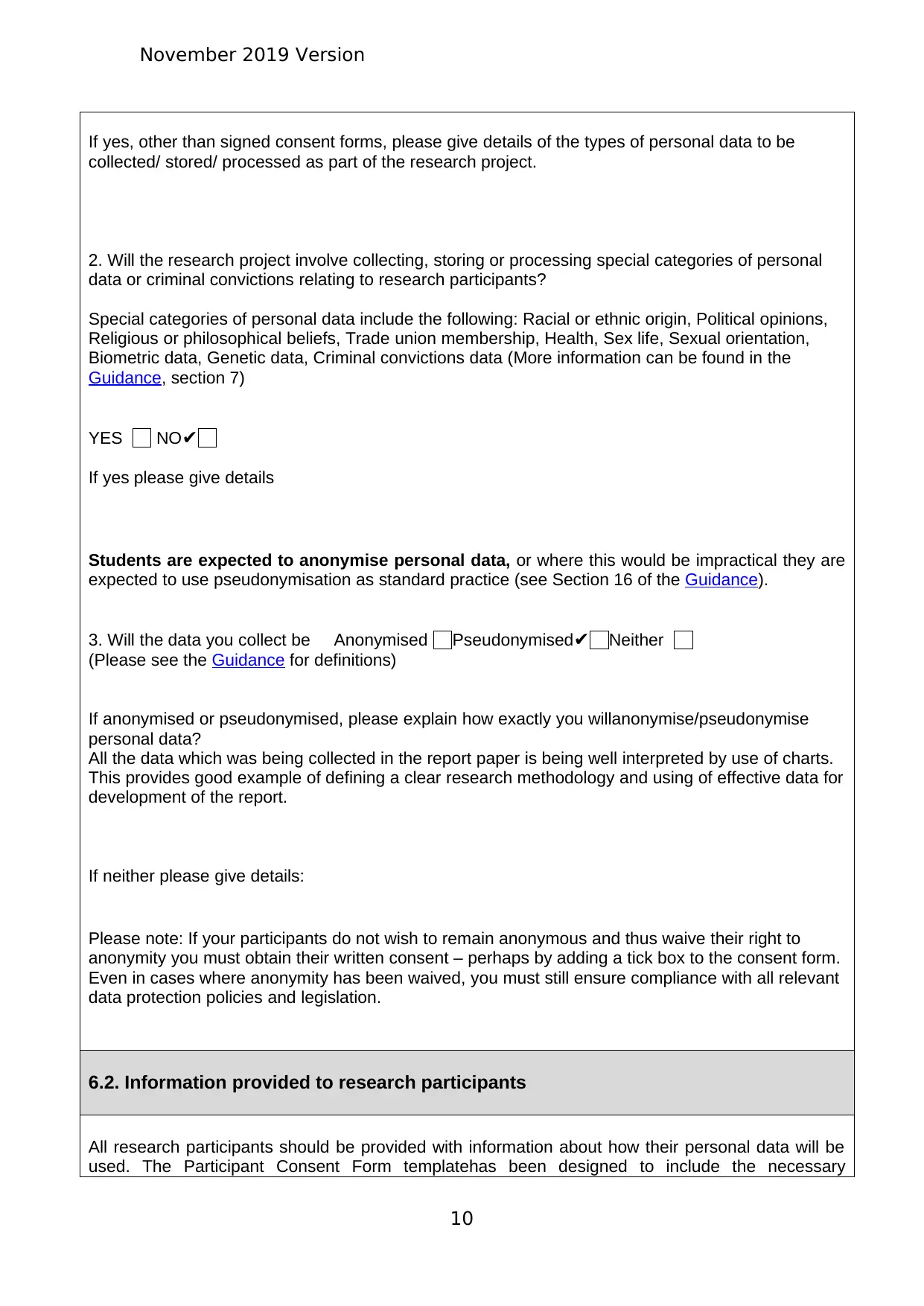
November 2019 Version
If yes, other than signed consent forms, please give details of the types of personal data to be
collected/ stored/ processed as part of the research project.
2. Will the research project involve collecting, storing or processing special categories of personal
data or criminal convictions relating to research participants?
Special categories of personal data include the following: Racial or ethnic origin, Political opinions,
Religious or philosophical beliefs, Trade union membership, Health, Sex life, Sexual orientation,
Biometric data, Genetic data, Criminal convictions data (More information can be found in the
Guidance, section 7)
YES NO✔
If yes please give details
Students are expected to anonymise personal data, or where this would be impractical they are
expected to use pseudonymisation as standard practice (see Section 16 of the Guidance).
3. Will the data you collect be Anonymised Pseudonymised✔ Neither
(Please see the Guidance for definitions)
If anonymised or pseudonymised, please explain how exactly you willanonymise/pseudonymise
personal data?
All the data which was being collected in the report paper is being well interpreted by use of charts.
This provides good example of defining a clear research methodology and using of effective data for
development of the report.
If neither please give details:
Please note: If your participants do not wish to remain anonymous and thus waive their right to
anonymity you must obtain their written consent – perhaps by adding a tick box to the consent form.
Even in cases where anonymity has been waived, you must still ensure compliance with all relevant
data protection policies and legislation.
6.2. Information provided to research participants
All research participants should be provided with information about how their personal data will be
used. The Participant Consent Form templatehas been designed to include the necessary
10
If yes, other than signed consent forms, please give details of the types of personal data to be
collected/ stored/ processed as part of the research project.
2. Will the research project involve collecting, storing or processing special categories of personal
data or criminal convictions relating to research participants?
Special categories of personal data include the following: Racial or ethnic origin, Political opinions,
Religious or philosophical beliefs, Trade union membership, Health, Sex life, Sexual orientation,
Biometric data, Genetic data, Criminal convictions data (More information can be found in the
Guidance, section 7)
YES NO✔
If yes please give details
Students are expected to anonymise personal data, or where this would be impractical they are
expected to use pseudonymisation as standard practice (see Section 16 of the Guidance).
3. Will the data you collect be Anonymised Pseudonymised✔ Neither
(Please see the Guidance for definitions)
If anonymised or pseudonymised, please explain how exactly you willanonymise/pseudonymise
personal data?
All the data which was being collected in the report paper is being well interpreted by use of charts.
This provides good example of defining a clear research methodology and using of effective data for
development of the report.
If neither please give details:
Please note: If your participants do not wish to remain anonymous and thus waive their right to
anonymity you must obtain their written consent – perhaps by adding a tick box to the consent form.
Even in cases where anonymity has been waived, you must still ensure compliance with all relevant
data protection policies and legislation.
6.2. Information provided to research participants
All research participants should be provided with information about how their personal data will be
used. The Participant Consent Form templatehas been designed to include the necessary
10
Paraphrase This Document
Need a fresh take? Get an instant paraphrase of this document with our AI Paraphraser
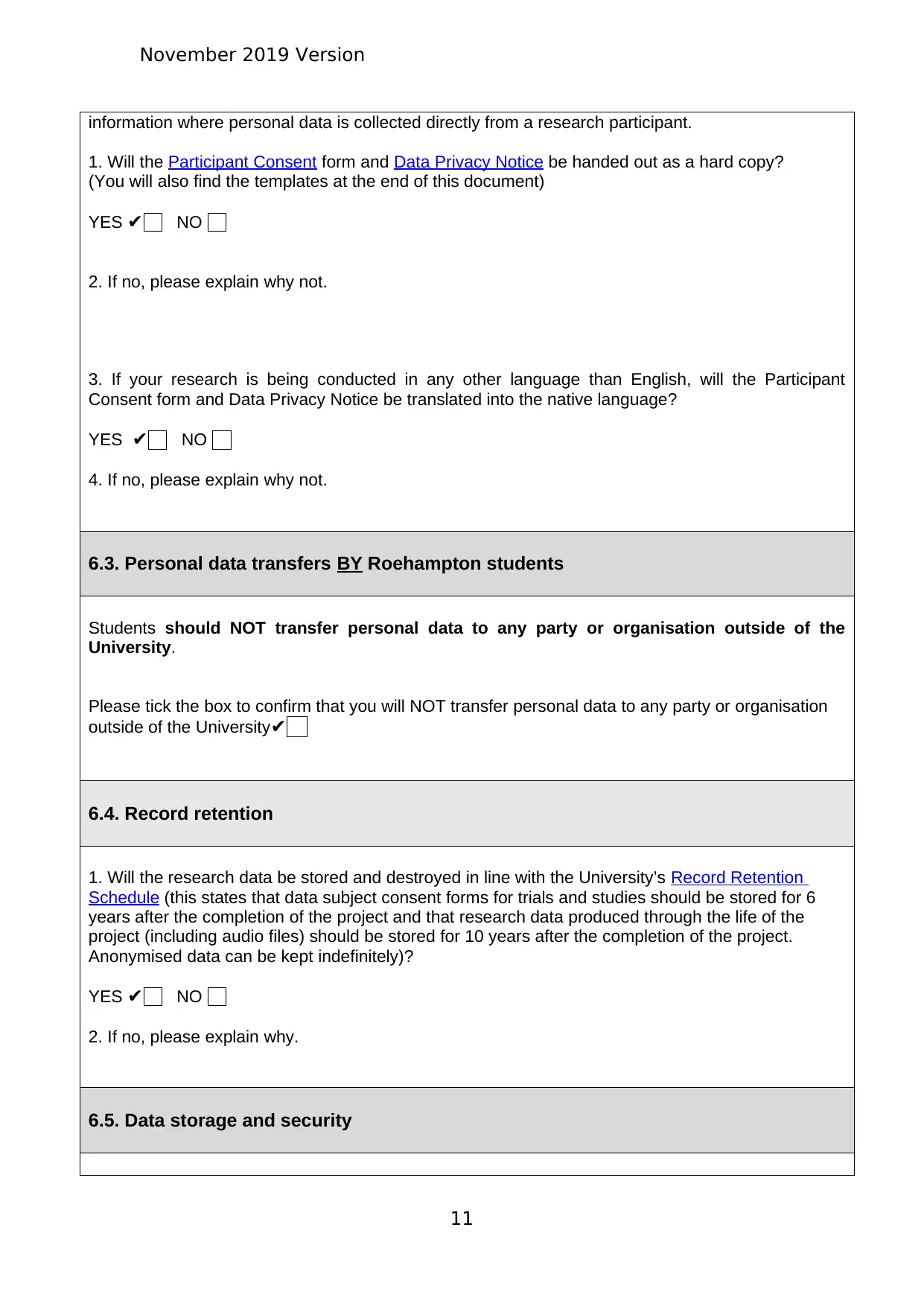
November 2019 Version
information where personal data is collected directly from a research participant.
1. Will the Participant Consent form and Data Privacy Notice be handed out as a hard copy?
(You will also find the templates at the end of this document)
YES ✔ NO
2. If no, please explain why not.
3. If your research is being conducted in any other language than English, will the Participant
Consent form and Data Privacy Notice be translated into the native language?
YES ✔ NO
4. If no, please explain why not.
6.3. Personal data transfers BY Roehampton students
Students should NOT transfer personal data to any party or organisation outside of the
University.
Please tick the box to confirm that you will NOT transfer personal data to any party or organisation
outside of the University✔
6.4. Record retention
1. Will the research data be stored and destroyed in line with the University’s Record Retention
Schedule (this states that data subject consent forms for trials and studies should be stored for 6
years after the completion of the project and that research data produced through the life of the
project (including audio files) should be stored for 10 years after the completion of the project.
Anonymised data can be kept indefinitely)?
YES ✔ NO
2. If no, please explain why.
6.5. Data storage and security
11
information where personal data is collected directly from a research participant.
1. Will the Participant Consent form and Data Privacy Notice be handed out as a hard copy?
(You will also find the templates at the end of this document)
YES ✔ NO
2. If no, please explain why not.
3. If your research is being conducted in any other language than English, will the Participant
Consent form and Data Privacy Notice be translated into the native language?
YES ✔ NO
4. If no, please explain why not.
6.3. Personal data transfers BY Roehampton students
Students should NOT transfer personal data to any party or organisation outside of the
University.
Please tick the box to confirm that you will NOT transfer personal data to any party or organisation
outside of the University✔
6.4. Record retention
1. Will the research data be stored and destroyed in line with the University’s Record Retention
Schedule (this states that data subject consent forms for trials and studies should be stored for 6
years after the completion of the project and that research data produced through the life of the
project (including audio files) should be stored for 10 years after the completion of the project.
Anonymised data can be kept indefinitely)?
YES ✔ NO
2. If no, please explain why.
6.5. Data storage and security
11
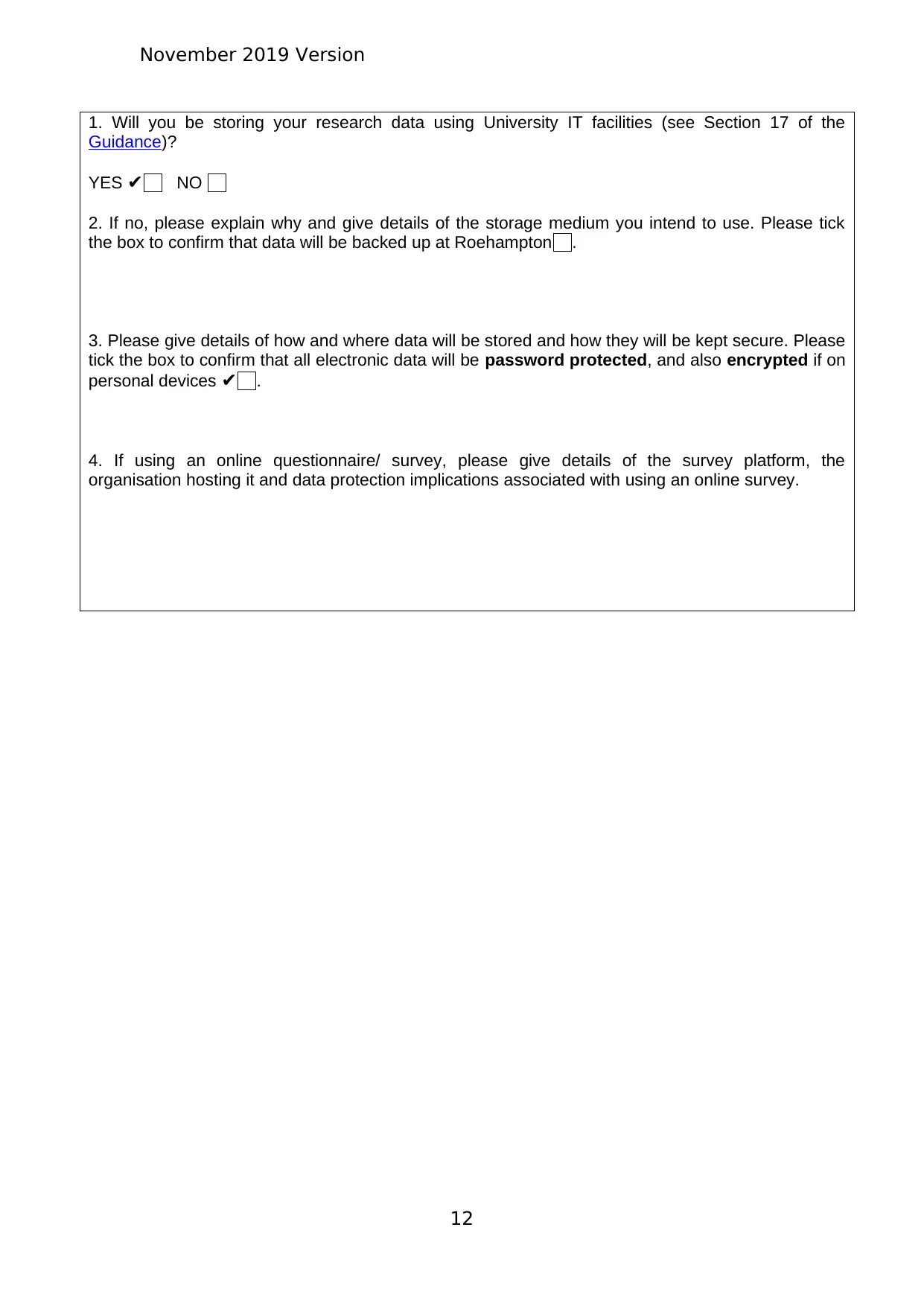
November 2019 Version
1. Will you be storing your research data using University IT facilities (see Section 17 of the
Guidance)?
YES ✔ NO
2. If no, please explain why and give details of the storage medium you intend to use. Please tick
the box to confirm that data will be backed up at Roehampton .
3. Please give details of how and where data will be stored and how they will be kept secure. Please
tick the box to confirm that all electronic data will be password protected, and also encrypted if on
personal devices ✔ .
4. If using an online questionnaire/ survey, please give details of the survey platform, the
organisation hosting it and data protection implications associated with using an online survey.
12
1. Will you be storing your research data using University IT facilities (see Section 17 of the
Guidance)?
YES ✔ NO
2. If no, please explain why and give details of the storage medium you intend to use. Please tick
the box to confirm that data will be backed up at Roehampton .
3. Please give details of how and where data will be stored and how they will be kept secure. Please
tick the box to confirm that all electronic data will be password protected, and also encrypted if on
personal devices ✔ .
4. If using an online questionnaire/ survey, please give details of the survey platform, the
organisation hosting it and data protection implications associated with using an online survey.
12
⊘ This is a preview!⊘
Do you want full access?
Subscribe today to unlock all pages.

Trusted by 1+ million students worldwide
1 out of 19
Related Documents
Your All-in-One AI-Powered Toolkit for Academic Success.
+13062052269
info@desklib.com
Available 24*7 on WhatsApp / Email
![[object Object]](/_next/static/media/star-bottom.7253800d.svg)
Unlock your academic potential
Copyright © 2020–2025 A2Z Services. All Rights Reserved. Developed and managed by ZUCOL.





